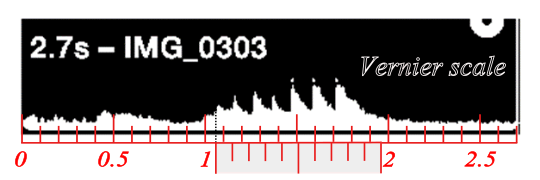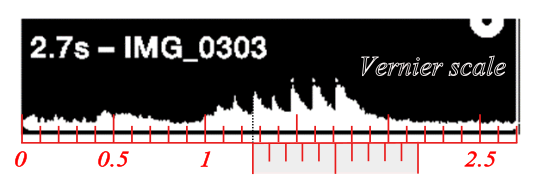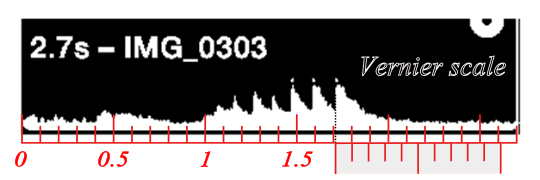Vernier scale
Jump to navigation
Jump to search

Here we use the Vernier scale to analyze data from Beads on string drop, a classroom measurement of Earth's gravitational acceleration.
There are two ways to use the resource in the classroom
- For a "hands-on" activity with scissors, the figure to the right can be copied, expanded, and printed on a sheet of paper. Students cut out the Vernier scale and measure the times associated with the rising edge of the peaks. These correspond to times when a paperclip strikes the coffee can.
- For a less time-consuming activity, a classroom with internet access could measure the times using the images in the following section.
Both methods recover the data required to experimentally measure g.[1]
Collecting the data from images with a Vernier scale[edit | edit source]
The first figure below shows the vernier at zero. The others verniers are aligned to the vertical dotted line (black) that represent the approximate time when a paperclip struck a coffee can. First guess the time and then hover your mouse over the figure and see if you got the right answer.
-
0.0 seconds
-
1.06 seconds
-
1.15 seconds
-
1.26 seconds
-
1.37+ seconds [2]
-
1.47 seconds
-
1.59− seconds [3]
-
1.71 seconds
- ↑ See Physics and Astronomy Labs/Beads on string drop
- ↑ The reader might notice that the value is a bit higher than 1.37
- ↑ The reader might notice that the value is a bit lower than 1.59




![1.37+ seconds [2]](http://upload.wikimedia.org/wikipedia/commons/thumb/f/fa/Paperclips_on_string_drop_sound_data_5.svg/540px-Paperclips_on_string_drop_sound_data_5.svg.png)

![1.59− seconds [3]](http://upload.wikimedia.org/wikipedia/commons/thumb/c/cb/Paperclips_on_string_drop_sound_data_7.svg/540px-Paperclips_on_string_drop_sound_data_7.svg.png)
